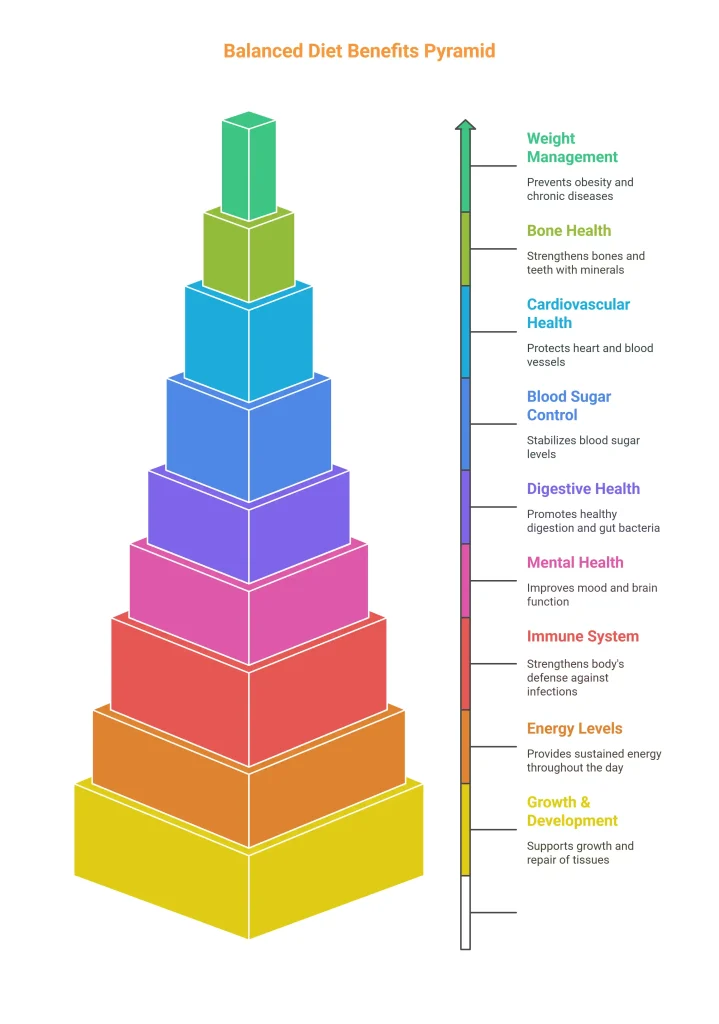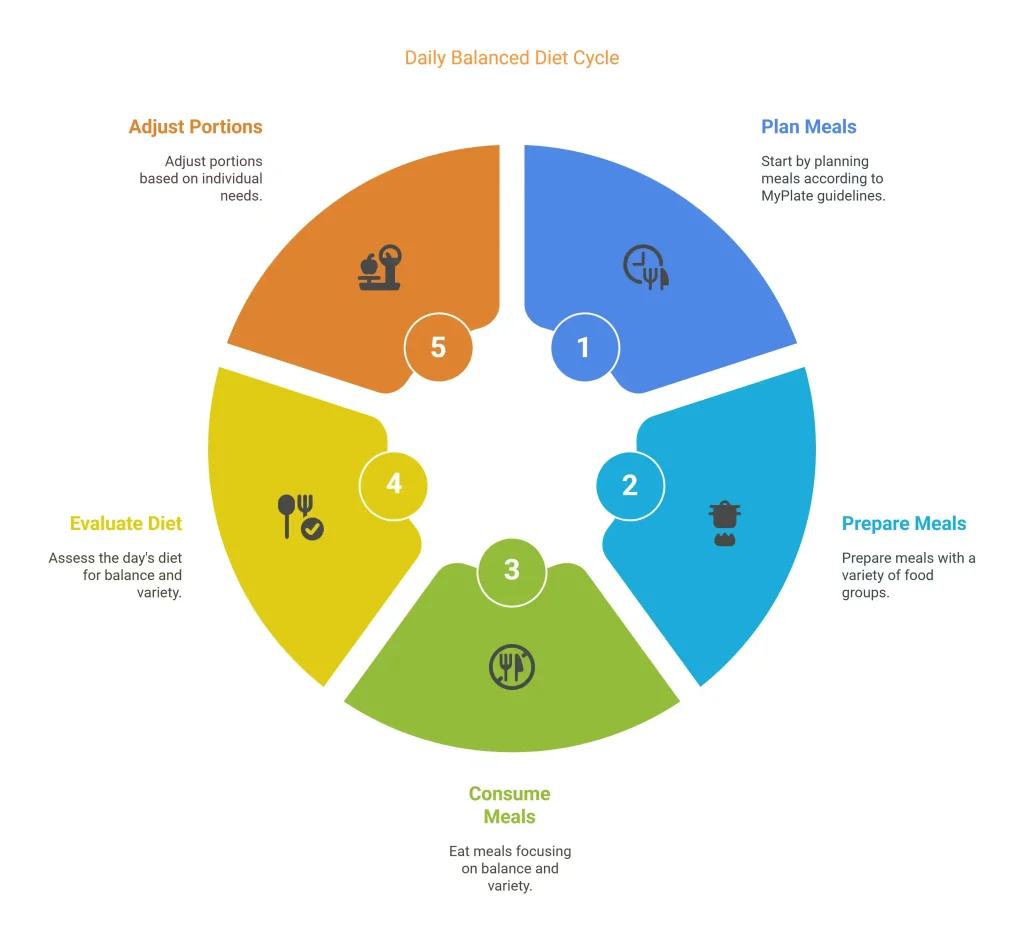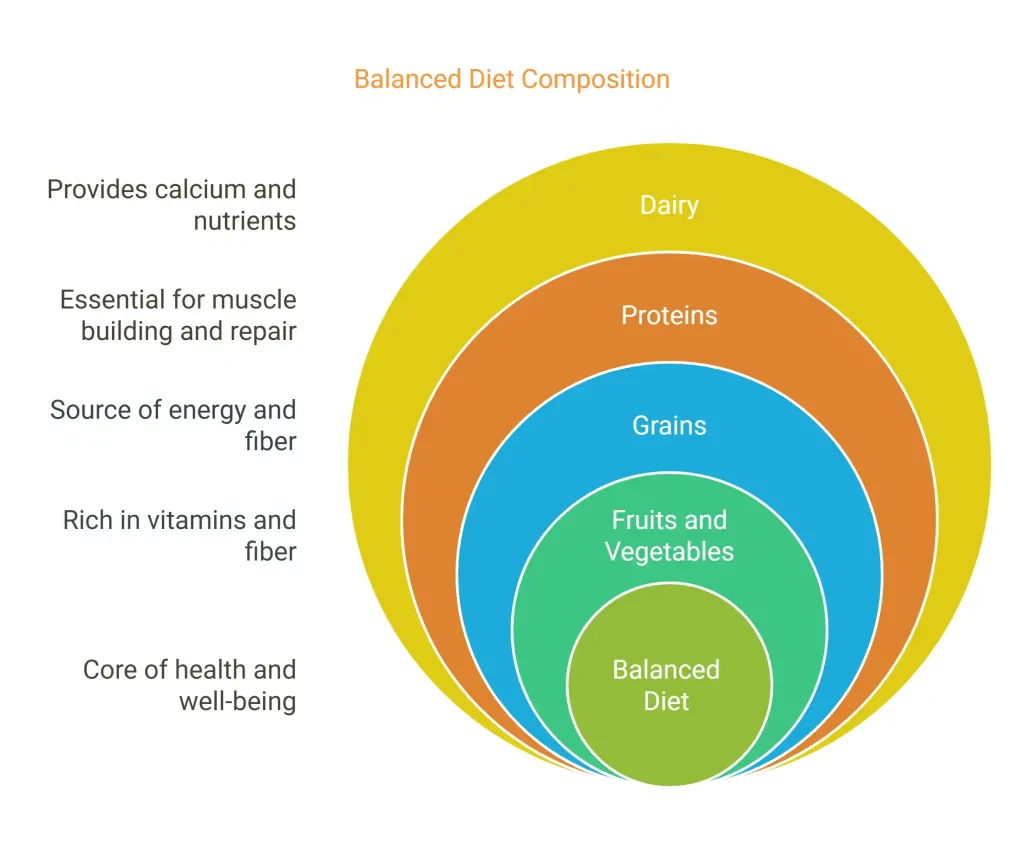Ever wonder “What is a balanced diet” and why everyone talks about it? A balanced diet gives your body all the nutrients it needs – proteins, carbs, fats, vitamins, and minerals – in the proper proportions. In other words, balanced nutrition means eating a mix of foods to avoid missing anything important. As one expert puts it, “A balanced diet supplies the nutrients your body needs to work effectively” Without that balance, our bodies become more prone to fatigue, illness, and low performance. Think of a balanced diet as a colourful plate: half fruits and vegetables, one quarter grains (preferably whole grains), and one quarter lean protein, plus some dairy or alternatives on the side. Getting this balance right is key to feeling good, staying energetic, and keeping long-term health on track.
A quick balanced nutrition definition: include something from all the major food groups daily. For example, the USDA’s MyPlate guide (pictured below) shows that a healthy meal should roughly be half fruits/veggies, a quarter protein, a quarter grains, plus a serving of dairy. That means loading up on fibre-rich plants (colourful fruits and veggies), having whole grains (like brown rice or oats) instead of white flour, choosing lean proteins (chicken, beans, fish, nuts) and low-fat dairy (milk, cheese, yoghurt). According to the USDA, fill half your plate with fruits and vegetables, about one quarter with grains, and one quarter with protein. A balanced diet would include items like apples, spinach, whole wheat bread, yoghurt, and a little olive oil – not just burgers or candy alone. In fact, a healthy diet like this “helps individuals achieve and maintain good health and reduce their risk of chronic disease”. In short, a balanced diet (balanced nutrition) is all about variety and proportion: get all your essential nutrients, without too much junk.
10 Importance of a Balanced Diet
Here are 10 significant reasons why eating a balanced diet matters for your body and mind:
1.Weight Management & Chronic Disease Prevention. Balanced eating helps you maintain a healthy weight. Eating plenty of vegetables, fruits, and lean proteins (which tend to be lower in calories than processed foods) makes it easier to avoid excess weight. Staying at a moderate weight slashes your risk of heart disease, type 2 diabetes, stroke, hypertension and even some cancers. In fact, experts note that obesity raises the risk of those exact diseases, so eating well and not overeating helps protect your heart and arteries.
2.Strong Bones and Teeth. Foods rich in calcium and magnesium keep bones and teeth strong. Dairy products, leafy greens, nuts, and fish with edible bones (like canned salmon) provide the minerals your skeleton needs. Getting enough of these nutrients in your diet minimises the risk of bone loss or osteoporosis later in life. So, an 8-year-old who eats yoghurt and broccoli helps build a strong frame, and an adult who keeps it up will thank their bones later.
3.Healthy Heart and Blood Vessels. A balanced diet protects your cardiovascular system. Diets high in fibre from fruits, veggies, and whole grains and low in saturated fat (found in fried foods, fatty red meat, etc.) help keep cholesterol and blood pressure in check. According to the WHO, eating a healthy diet “helps to protect against… heart disease, stroke and cancer”. In other words, filling your plate with produce and whole foods (instead of chips and candy) makes heart attacks and strokes less likely.
4.Blood Sugar Control. Balance helps keep blood sugar steady. Including whole grains, lean protein, and fibre-rich foods slows sugar absorption. This can prevent spikes and crashes that lead to energy slumps or cravings. It also lowers the risk of type 2 diabetes. (Note: Even the WHO fact sheet warns that unhealthy diets raise diabetes risk.) In short, eating balanced means energy stays stable and your body handles carbs better, reducing the chance of insulin resistance over time.
5.Good Digestion and Gut Health. Fibre from fruits, vegetables, beans, and whole grains fuels a healthy digestive system. Fibre adds bulk to the stool, promotes regularity, and feeds good gut bacteria that crowd out inflammation. Studies show a high-fibre diet can reduce gut inflammation and improve digestion. A happy gut means fewer stomach issues (like constipation or IBS symptoms) and a stronger immune system overall.
6.Better Mood and Brain Function. What you eat affects how you feel and think. Diets rich in whole foods (like the Mediterranean diet) have been linked to better mental health, while diets high in junk food can make mood worse. One recent review found that micronutrients (B-vitamins, iron, antioxidants from fruits/veggies) support brain health. In plain terms: when your diet includes plenty of healthy fats (from fish, nuts), vitamins (from produce), and protein, you’re fueling your brain. This can translate to a sharper memory, a more stable mood, and a lower risk of depression.
7.Stronger Immune System. A balanced diet primes your body to fight off germs and infections. You can’t magically eat one food to “boost” immunity, but getting all the necessary vitamins and minerals does make a difference. As the Harvard School of Public Health notes, a diet with a “range of vitamins and minerals” (from real food) is one of the best ways to prepare the body to resist disease. For example, vitamin C from citrus fruits and leafy greens, vitamin D from milk or sun, and zinc from nuts all support immune cells. In sum, nutrient-rich foods mean your immune system runs on all cylinders.
8.Steady Energy Levels. When all nutrients are balanced, you avoid the energy rollercoaster. Carbohydrates give fuel, protein provides lasting fullness, and healthy fats keep cells running smoothly. Skipping one group (e.g. no carbs) or eating too much sugar causes quick crashes. In fact, Healthline points out that our body “needs nutrients to stay healthy, and food supplies essential nutrients that stop us from getting sick”. Conversely, a balanced meal (oats + yoghurt + fruit, say) will give you smooth, sustained energy.
9.Healthy Growth and Development (Especially for Kids). For children and teens, a balanced diet literally builds bodies and brains. Kids without nutritious food can suffer growth delays, developmental issues, and worse immune defence. Even adults benefit: when we eat a full spectrum of nutrients, our tissues repair and our muscles stay strong. In other words, whether you’re a growing 7-year-old or a 70-year-old grandparent, balanced nutrition helps keep bones dense, muscles toned, and organs functioning well.
10.Overall Well-being and Longevity. Last but not least, eating well boosts every aspect of health. Without a balanced diet, we are “more prone to disease, infection, fatigue, and low performance”. Conversely, getting the right mix of nutrients means your body has what it needs to repair itself, regulate hormones, and fight disease. Over the years, this adds to living longer, feeling better day-to-day, and spending more time doing what you love. Balanced meals aren’t just a diet fad – they’re a foundation for a healthy life.

What Are Healthy Foods?
When we talk about a balanced diet, the centrepiece is healthy foods. So what does that mean? Healthy foods are nutrient-packed goodies that benefit your body: lean proteins, whole grains, fruits, vegetables, nuts and seeds, and low-fat dairy. If nature made it or it’s minimally processed, it’s probably a good choice. These foods give you vitamins, minerals, fibre and healthy fats instead of empty calories. For example, the UK’s National Health Service (NHS) advises filling your diet with at least five different portions of fruits and vegetables each day, basing meals on high-fiber whole grains (potatoes, brown rice, whole-wheat bread/pasta), and including moderate amounts of protein (fish, beans, eggs, lean meat) and dairy or alternatives. In casual terms, “healthy foods” (sometimes called diet healthy) make up a well-rounded plate – colourful veggies, whole grains, lean protein, etc. These contrast with processed snacks or sugary drinks, which we enjoy occasionally but don’t count as healthy staples.
The photo above shows a variety of healthy foods: fresh fruits (like oranges, kiwi, tomatoes) and a piece of fish on ice. Fruits, veggies and fish are loaded with fibre, vitamins and healthy fats – the nutrients your body needs. By filling your plate with these foods, every bite works in your favour. (In fact, experts emphasise that “a balanced diet [with] a range of vitamins and minerals… most effectively primes the body to fight infection and disease.”) Picking healthy foods means choosing whole or minimally processed items and limiting things like fast food, chips, candy, and sugary drinks. Over time, those simple swaps can make your entire diet healthier.
Example of a Balanced Diet
Make this concrete with a sample daily menu (U.S. style). The idea is to show how variety and portions come together in real meals.
Imagine the USDA’s MyPlate as a starting template: half your plate with vegetables/fruits, a quarter with grains, a quarter with protein, plus dairy on the side. Here’s what one day might look like:
- Breakfast: Oatmeal (whole grain) topped with mixed berries (fruit) and a sprinkle of nuts. On the side, 2 scrambled eggs (protein). Consider including a small glass of low-fat milk or fortified plant milk (dairy). This covers grains + fruit + protein (and dairy for calcium).
- Morning Snack: A piece of fruit (like an apple or banana) or a cup of yoghurt. This adds extra vitamins and protein/fibre to keep hunger at bay.
- Lunch: A big salad or bowl of mixed greens and colorful veggies (spinach, tomatoes, carrots) topped with grilled chicken or chickpeas (protein) and a serving of whole grains (brown rice, quinoa, or a whole-wheat roll). Drizzle with olive oil/vinegar (healthy fat) and sprinkle on some beans or nuts for extra nutrients.
- Afternoon Snack: Carrot sticks, bell pepper slices with hummus, or a handful of almonds and a small orange. This ensures more veggies or nuts, which are healthy foods.
- Dinner: Grilled fish (like salmon, for lean protein and omega-3 fats) or chicken, with a cup of steamed vegetables (e.g. broccoli, cauliflower, zucchini) and about 1 cup of a whole grain (brown rice, whole-wheat pasta, or a sweet potato). Add a side of beans or lentil soup (extra protein and fibre) and a small salad.
- Evening (if hungry): A small glass of milk or a few whole-grain crackers with cheese can round things out.
This menu hits all the food groups: fruits, veggies, whole grains, proteins, and dairy, as MyPlate recommends. You’ll notice we’re not piling on junk food or empty snacks; instead, we get flavour from herbs/spices, healthy fats (olive oil, nuts), and natural sweetness from fruit. You also don’t have to measure obsessively – the point is variety and balance. Of course, each person’s exact portions would vary by age and activity level (the USDA’s MyPlate Plan tool can customise amounts for you), but the general idea is to mix things up. By the end of the day, you’d have met multiple servings of veggies and fruits, had whole grains instead of refined carbs, chosen lean proteins, and kept sugary or fried foods to a minimum.

Tips for Keeping a Balanced Diet
Turning the idea of “balanced diet” into reality can be easy with a few practical swaps and habits. Here are some friendly tips (backed by nutrition advice) to help keep your diet on track:
- Drink water (or tea) instead of sugary drinks. Sodas, energy drinks and sweetened coffees pack in extra calories and sugar with no nutrients. Swap these for plain water, sparkling water with fruit, or unsweetened tea. It’s a simple change that cuts empty calories.
- Choose whole grains over refined carbs. Instead of white bread, rice, or pasta, go for whole-grain bread, brown rice, oatmeal, or quinoa. These options have more fibre and keep you full longer.
- Add more fruits and veggies. Aim to make half of your plate vegetables and fruits at each meal. They’re rich in fibre and nutrients. For example, toss extra spinach in your pasta or add more berries to your breakfast yoghurt. Even simple: chop up some fruit or carrot sticks and prepare them for snacks.
- Lean on lean proteins. When choosing meat, go for poultry, fish, or plant proteins (beans, lentils) more often. Limit red meat and processed meats. Grilled chicken or beans in salads and fish on the grill are excellent choices for a balanced diet.
- Be mindful, not perfectionist. A balanced diet isn’t about perfection or strict rules. If you indulge occasionally (e.g., a doughnut or a cheesy slice of pizza), that’s OK. Just balance it out by returning to healthy choices at the next meal. Overall, aim for whole foods most of the time.
These kinds of swaps and habits add up. The American Heart Association also recommends these moves: swapping sweet drinks for water, choosing whole grains, and piling up the produce. As you try them, you’ll likely feel fuller on fewer calories, have steadier energy, and even a brighter mood after meals.

Putting It All Together
In a nutshell, a balanced diet means covering all your nutritional bases without overdoing the junk. It’s not an overly strict plan; it’s about filling your plate with a colourful variety of natural foods most of the time. When you focus on healthy foods (fruits, veggies, whole grains, lean protein, low-fat dairy, and healthy fats), your body gives you better health, more energy, and a stronger immune system. Try the sample meal ideas above, or keep the MyPlate picture in mind for each meal (half vegetables, etc.).
Remember: even small changes help. Next time you cook, use half wheat flour instead of white; when you snack, reach for berries or nuts instead of chips; make one meal this week a meatless bean chilli instead of takeout. These little steps are the building blocks of a balanced diet. With time, eating this way becomes second nature—it’ll feel less like dieting and more like a usual, nourishing way. Your body will reward you by staying healthier and stronger.
Eating well doesn’t have to be complicated. A balanced diet is simply putting quality over quantity in every bite. As you make it a habit, you’ll likely notice life feeling slightly brighter (and your pants fit better). Stay curious, keep it fun, and enjoy exploring new healthy foods. Your future self will thank you!
Sources: Evidence for these tips and definitions comes from nutrition authorities and research. For instance, Healthline and the USDA explain the food-group approach to balance, and organisations like the NHS and WHO highlight how a varied diet protects health. Harvard’s Nutrition Source notes that a diet rich in vitamins/minerals supports immunity. Altogether, the science clearly says balance and variety are key.
What exactly is a balanced diet?
A balanced diet means eating foods from all the major food groups — fruits, veggies, whole grains, protein, dairy, and healthy fats — in the right amounts. It gives your body all the necessary nutrients to work correctly, without overloading on sugar, salt, or unhealthy fats.
Why is a balanced diet essential for health?
Because it keeps your body running smoothly. It helps prevent diseases like heart issues, diabetes, and obesity. Plus, it supports strong bones, good energy levels, a better mood, and even a stronger immune system.
What are some examples of healthy foods I should eat daily?
Fruits (like apples or berries), vegetables (spinach, carrots, broccoli), whole grains (brown rice, oats), lean proteins (chicken, fish, beans), low-fat dairy (milk or yoghurt), and healthy fats (nuts, olive oil). Real food over processed stuff.
Do I need to cut out all junk food to have a balanced diet?
Nope! It’s not about being perfect — it’s about balance. It’s OK to enjoy treats like pizza or cookies now and then, as long as most of your meals are filled with nutritious whole foods.
How can I make my meals more balanced without overthinking them?
Use the “MyPlate” rule: Half your plate should contain fruits and veggies, a quarter whole grains, and a quarter lean protein. Add a side of dairy, and you’re good. Think colourful and varied.
Can a balanced diet help me lose weight?
Yes, for sure. Eating whole, fibre-rich foods keeps you fuller longer and helps prevent overeating. Balanced meals support a steady metabolism and better energy, which helps with exercise and fat-burning.
Is a balanced diet the same for everyone?
Not exactly. The basics stay the same, but your needs can depend on age, activity level, health conditions, or goals. But everyone benefits from eating more whole foods and fewer processed ones.
How does a balanced diet support mental health?
Foods rich in vitamins, healthy fats, and protein support brain health and mood. Diets high in junk food can lead to more mood swings or low energy. So yeah, your food choices really affect how you feel mentally.
What’s a quick, balanced meal I can make at home?
Try this: Grilled chicken with brown rice and steamed broccoli, a veggie-loaded salad with chickpeas and olive oil dressing, or oatmeal with berries and nuts for breakfast. It’s easy, quick, and super nourishing.
How much water should I drink with a balanced diet?
If you’re active, aim for about 8 cups (64 oz) daily. Water helps your body absorb nutrients, support digestion, and maintain energy levels. Skip the sugary drinks—they add empty calories.











Discussion about this post